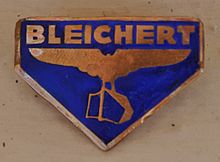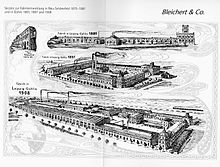Bleichert
51°21′47″N 12°22′33″E / 51.3631°N 12.3757°E
 | |
| Industry | Cable Car, Automotive Industry, Arms Industry |
|---|---|
| Founded | 1874 |
| Founder | Adolf Bleichert |
| Defunct | 1993 |
| Headquarters | |
Key people | Max von Bleichert / CEO, Paul von Bleichert / CFO |
Number of employees | 90 (1881)
3.200 (1928) 169 (1932) 4.000 (1950) |
Bleichert, short for Adolf Bleichert & Co.,[1][2] was a German engineering firm founded in 1874 by Adolf Bleichert. The company dominated the aerial wire ropeway industry during the first half of the 20th century, and its portfolio included cranes, electric cars, elevators, and mining and ship-loading equipment.



History
1874 until 1918
In 1872 Adolf Bleichert started in Teutschenthal (Saxony, Germany) the design and manufacture of the first wire rope way (also called Aerial lift). Simultaneously with the successful start-up of this installation Adolf Bleichert founded (initially together with Theodor Otto) in 1874 near to Leipzig a company for the manufacture of wire rope ways. This was the beginning of Adolf Bleichert & Co. which in the 50 years, starting from 1874 until the middle of the 20th century, developed into a world renowned company of the highest standing. In 1881 Bleichert moved its offices to Leipzig-Gholis, which became the main factory facility located in a much bigger plant[3] and it also was the Headquarter of the company.
Starting from 1888 Bleichert expanded also to the Northamerican market by concluding a license agreement with the American company Cooper, Hewitt & Co., the mothercompany of the Trenton Iron Inc.,[4] which constructed and sold many material wire rope ways based on the Bleichert system.
During World War I the Bleichert company developed a specific "field cable car" used by German military forces in mountain warfare in the Vosges Mountains, the Alpine and Balkan areas.
Until World War I the Bleichert company realized many aerial cable cars, especially for material carriage, but even for passengers transportation, among this have been built the following in:
- 1874: Aerial cableway installation on round bar rails for the solar oil and paraffin factory in Teutschenthal near Halle, Germany
- 1876: Ropeway conveyor for the material transportation of Sayn Mine Works from Krupp company near to Bendorf, Germany
- 1880: Aerial cableway for the transportation of iron ore from the Doihl Mine to the steelworks in Rodange, Luxembourg
- 1890: Aerial cableway for the wood transportation of the Baina-Buschta region, Serbia
- 1900: Aerial cableway for the miningworkings of the Kappler-Tunnel at the Schauinsland mountain in the Black Forest near to Freiburg im Breisgau, Germany
- 1902: Aerial cableway for the coalmine activities at Grand-Hornu, Belgium
- 1903: Aerial cableway for the coalmine activities at the Sumitomo-Besshi Copper Mine in Niihama, Japan
- 1904: Aerial cableway for the Harpener Bergbau AG former mining company near to Dortmund, Germany
- 1905: Aerial cableway for the Chilecito-La Mejicana gold mining industry, also called cable car from the Famatina pit, Argentina
- 1906: Aerial cableway for the nickel ore loading facility of Société Le Nickel on the pacific coast at the French overseas territory of Thio, New Caledonia
- 1906: Aerial cableway for the cement industry Alsenschen Portland-Zementfabrik in Itzehoe–Agethorst / Wacken, Germany
- 1908: Aerial cableway for the cole mining industry in Longyearbyen, Spitsbergen (Svalbard islands), Norway
- 1909: Aerial cableway for the wood transportation of a sawmill in Mkumbara – Neu Hornow, former German East Africa
- 1909: Aerial cableway for the material trasportation of Toli Mines in the coal mining district of Shandong coastal province, China
- 1913: Passengers aerial cableway Kohlerer Bahn in Bolzano, South Tyrol (former Austria-Hungary), Italy
- 1913: Aerial cable cranes for the construction of the Centennial Hall in Wroclaw (Lower Silesia), Poland

1918 until 1945
Bleichert mainly built material carrying wire rope ways, but then diversified into passenger cable cars as well, such as the famous Predigtstuhl Aerial Tramway in the Alps, the Tyrolean Zugspitze Cable Car, Krossobanen in Norway, Table Mountain Aerial Cableway in South Africa, Burgberg Cable Car in Germany, Aeri de Montserrat in Catalunya and the Port Vell Aerial Tramway crossing the Port of Barcelona from Torre Sant Sebastia via Torre Jaume I to Montjuïc, just to mention some of those.

By the company’s 50th Anniversary in 1924, Adolf Bleichert & Co. had designed and built the world's record holding wire ropeways: Longest and highest elevation (Argentina); Length of system over water (New Caledonia); Steepest (Tanzania); Highest capacity (France); Northernmost (Norway); and, Southernmost (Chile).
In 1926, the company went public, though was controlled by Bleichert’s two sons: Max von Bleichert and Paul von Bleichert. Due to the Great Depression and the collapse of the German banking system, on April 4, 1932, Adolf Bleichert & Co. filed for bankruptcy. Its successor, Bleichert-Transportanlagen GmbH, was incorporated on June 28, 1932 to carry on the firms work. Bleichert-Transportanlagen GmbH also became sole shareholder of Adolf Bleichert & Co. Drahtseilbahn GmbH, the people-mover manufacturing entity. Bleichert-Kabelbagger GmbH—the wire rope crane division—became an independent entity, though also declared bankruptcy on July 4, 1932.
No longer under Bleichert family control, the Bleichert-Transportanlagen GmbH factory continued to produce during the Second World War.
From 1945
With the defeat of Nazi Germany, Leipzig—the Saxon city where much of the company's factories were centered—fell on the eastern side of the Iron Curtain and Bleichert-Transportanlagen GmbH was taken over by the Occupying Power, the Soviet Union, and renamed SAG Bleichert. In 1954, SAG Bleichert[5] was transferred to the German Democratic Republic (East Germany), and was renamed VEB Bleichert. Soon thereafter, the firm was continued under the name VEB Transportanlagenfabrik Bleichert Leipzig. In 1955, the company name changed again to VEB Schwermaschinenbau Verlade- und Transportanlagen Leipzig vorm.Bleichert. By 1959, the last reference to the original family business disappears, as ‘vorm.Bleichert’ is dropped from the firm’s name. Between 1962 and 1985, this entity went through several iterations. However, by 1991, the company had been privatized and entered liquidation, halting production of cranes, conveyance, and pit mining equipment — thus concluding the history of the oldest and largest wire ropeway manufacturer of the world.


Further reading
- Dr. Manfred Hötzel; Stefan W. Krieg: Adolf Bleichert und sein Werk. An entrepreneurs biography, industrial architecture and company history. (=Gohliser Historische Hefte, Bd. 8), Sax Verlag, Beucha 2007, ISBN 978-3-934544-35-2. Also see [1]
- Dr. Peter von Bleichert: Adolf Bleichert & Co.'s Wire Rope Systems, KDP, 2019 ([2])
- Oliver Werner: Ein Betrieb in zwei Diktaturen. Von der Bleichert-Transportanlagen GmbH zum VEB VTA Leipzig – 1932 bis 1963. (=Beiträge zur Wirtschafts- und Sozialgeschichte, Nr. 101), Steiner, Stuttgart 2004, ISBN 3-515-08544-0
- P. Stephan: Die Drahtseilbahnen. Ihr Aufbau und ihre Verwendung. Verlag von Julius Springer, Berlin 1914 (Digitalisat)
External links
- Family and Company Website: Bleichert & Co. - The Wire Ropeway Dynasty
- Facebook page: Bleichert's Wire Ropeways
References
- ^ "Adolf Bleichert – der Erfinder des deutschen Drahtseilbahnsystems". Seilbahngeschichte.de. Archived from the original on 2011-10-11. Retrieved 2010-06-18.
- ^ Dr. Manfred Hötzel. "Adolf Bleichert und sein Werk".
- ^ "Die Fabrik für Drahtseilbahnen Adolf Bleichert". Leipzig-gohlis.de. Retrieved 2010-06-18.
- ^ Trenton Iron later was incorporated into United States Steel Corporation through its subsidiary American Steel and Wire Company.
- ^ "Plakat aus der Bleichert-Ausstellung in Dresden-Loschwitz". Ercl.net. Archived from the original on 2012-07-30. Retrieved 2010-06-18.
